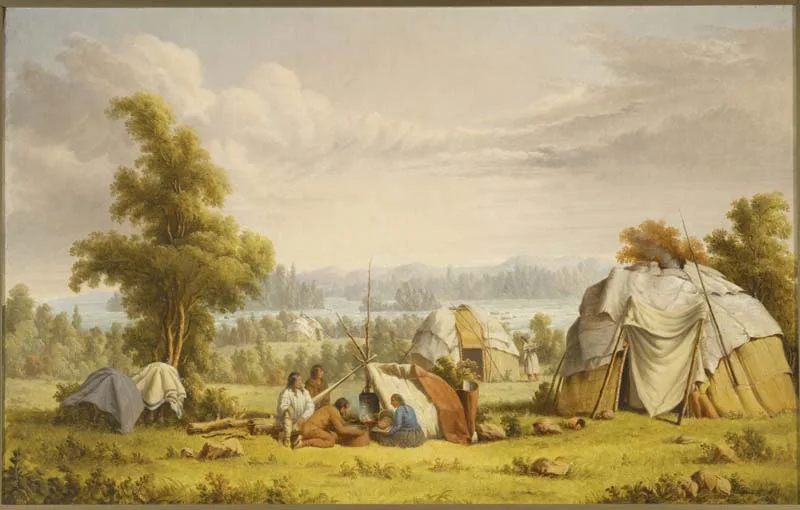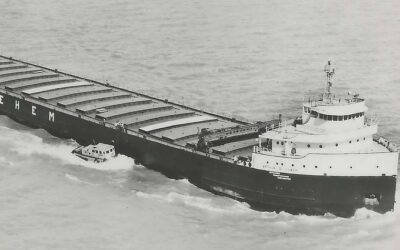
The Poe Lock, August 3, 1896. (Source: National Archives)
How Michigan’s oldest settlement became a transportation hub.
While most of us know how rich Michigan’s history is, not all of us know that our Upper Peninsula is actually home to one of the oldest cities in the Midwest.
Of course, Native Americans have called our region home for thousands of years. But when we’re talking about establishing the state of Michigan as we know it today, we need to travel back to 1668, when French colonists arrived in Sault Ste. Marie—just 40 years after pilgrims landed at Plymouth Rock.
That’s where our story starts today.
The founding of Sault Ste. Marie

The Ottawa and Ojibwa at Sault Ste. Marie. Painting by Paul Kane, 1840s (Source: Royal Ontario Museum)
It’s important to emphasize that when we refer to Sault Ste. Marie as one of the Midwest’s oldest cities, we’re specifically referring to it in the scope of being a European-founded settlement.
The roots of civilization in the region trace back thousands of years to Native Americans who called the area home. Members of various Sioux tribes lived here until the 1300s, when the Anishinaabe’s Ojibwe Peoples began to settle in what we now think of as the Upper Peninsula of Michigan.
The nearby rapids of St. Marys River were an important part of daily life for the Ojibwe, and they named the area Bahweting (meaning “at the cascading rapids”).
According to the Sault Ste. Marie Tribe of Chippewa Indians, life consisted of gathering for the summers in places like Bahweting before breaking up into family units for the winter. Anishinaabeg would hunt, fish, and gather and preserve food for the winter.
This way of life continued for centuries until 1668, with the arrival of French missionaries Claude Dablon and Jacques Marquette. They would make Sault de Sainte Marie into a Jesuit mission—the oldest permanent European settlement in Michigan.
The centuries that followed brought tremendous changes to the area. Sault Ste. Marie—pronounced “Sue Saint Marie,” and translated to the rapids of Saint Mary—sits at the connection of Lake Superior and Lake Huron. From there, boats and ships can reach the Great Lakes St. Lawrence Seaway system, which travels through Lake Erie, Lake Ontario, and the St. Lawrence River to reach the Atlantic Ocean.

(Source: Britannica.com)
It’s not surprising, then, that “the Soo” became an important hub for the fur trade, with ownership of the region shifting between nations. First, from the French to the British in 1763, then, on the cusp of the 19th century, to the Americans.
These changes were not for the benefit of the local Native population. More treaties—including the 1820 Treaty of Sault Ste. Marie and the 1836 Treaty of Washington—forced Anishinaabe people to move away from the area (at best).
Though trade continued to be an essential part of life in the area, there was one big issue: The rapids of the St. Marys River—where water fell 21 feet—made transporting larger cargo difficult. But this would soon change.
Read more:
- Soo Locks, Sault Ste Marie LIVE stream
- Story of Our People: The Sault Ste. Marie Tribe of Chippewa Indians
- 9 Things You May Not Know About the Soo Locks
- The Sault Historic Sites
- How the Locks Work at Sault Ste. Marie
Building the Soo Locks

The Poe Lock, August 3, 1896. (Source: National Archives)
As we fast forward to the 1840s, Michigan is now a young state. For years, lawmakers in the Mitten had been asking the US government to build a canal and locks at Sault Ste. Marie, arguing that it would benefit the entire country.
But not all lawmakers agreed. It’s said that during one congressional hearing, lawmaker Henry Clay argued against the plan by reminding everyone how remote the Upper Peninsula was, equating creating a canal there to placing one “on the moon.”
But in the mid-1840s, public mood quickly changed following the discovery of copper and iron ore in the UP. These materials needed to be shipped to Cleveland and Detroit for processing, but once again, the rapids of the St. Marys River made this trip more time-consuming than needed. Materials had to be removed from ships and transported around the rapids.
In 1852, the US government gave Michigan 750,000 acres of land so they could finance the canal, with construction beginning in the summer of 1853.
You might be wondering, “How do these lock systems work?” In the simplest terms, not all water systems are nice and level. Like the rapids of the St. Marys River, certain geographical features make boat traversal difficult, if not downright impractical. That’s where these locks come into place. Think of them as elevators for boats. A boat enters a canal and is locked into place. Then, the water level rises or lowers, depending on its direction, allowing it to continue its journey.
Nearly 2,000 men signed on to the project at the height of its construction, working long hours—up to 12-hour days—in frequently dangerous conditions. Along with the hardships that winter brought, a cholera outbreak killed many men at one point.
Finally, in 1855, the Soo Locks opened for shipping. The first boat to pass through—the steamer Illinois—passed over the rapids in less than an hour.
In its first summer alone, boats carried almost 1,500 tons of ore through the Soo Locks. Five years later, that number grew to 120,000 tons.
Sault Ste. Marie in modern times

USCGC Mackinaw passes through Soo Locks, March 14, 2013. (Source: USCGC)
As the years passed, cargo shipping continued to increase in the area. And with that growth, officials built new and better locks to accommodate the larger vessels passing by.
In the present day, the United States Army Corps of Engineers, Detroit District, operates and maintains the two locks in service: the Poe Lock and the MacArthur Lock. The Poe, the larger of the two locks, was first built in 1896 before being rebuilt in 1968 to fit larger ships. It can take ships carrying 72,000 short tons.
According to the city of Sault Ste. Marie, the locks move nearly 86 million tons of cargo annually—including 95% of the United States’ iron ore.
An average of 10,000 ships pass through the locks each year, save for during the winter when ice shuts down Great Lakes shipping. During this time, maintenance is done on the locks.
A new lock is also being constructed, with an expected completion date of 2030.
The city of Sault Ste. Marie has also seen vast changes. With a population of 13,337, It’s now the second-most populated city in the UP—behind Marquette. Beyond being a transport hub, it’s also an academic hub, as the home of Lake Superior State University.
Tourism continues to be the major economic driver of the area, with many visitors flocking to its nearby lighthouses and nature sites. With how much has changed since its founding—and how the Soo Locks continue to be improved to this day—this modern marvel of the Great Lakes is a far cry from how it started.

7 creepy facts about Michigan they don’t teach you in school
Immerse yourself in the spirit of the season with seven creepy (or simply unexplained) facts about Michigan that textbooks ignore. Disappearing...

That one time in Michigan: When an official funeral was held for frozen pizzas
The next time you’re forced to discard a recalled product, draw inspiration from one of Michigan’s most inventive pizza producers. We’ve all...

Great Lakes features mystery triangle blamed for disappearances. Is the legend true?
Beware when heading out onto Lake Michigan—legend says ships are known to vanish in what's known as the Lake Michigan Triangle, or do they? The area...

5 unsung films that dramatize America’s rich labor history
By Peter Dreier, Occidental College The U.S. is in the midst of a new upsurge of union organizing. Is a Hollywood drama about angry Starbucks...

St. Clair: The storybook Michigan town with a surprising world record
St. Clair, Michigan, not only exudes charm and offers plenty of adventures, but it also boasts an impressive world record. As a lifelong resident...





